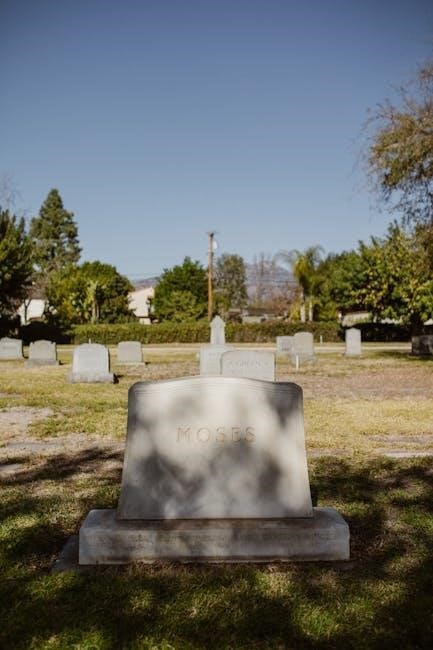funeral blues pdf

Funeral Blues, also known as “Stop All the Clocks,” is a poignant poem by W.H. Auden, expressing profound grief and loss. Its themes of mourning and emotional hyperbole resonate deeply, making it a popular choice for memorials. Available as a PDF download, it offers comfort and solace to those grieving, while its universal appeal continues to inspire readers worldwide.

Author Background: W.H. Auden
Wystan Hugh Auden, known as W.H. Auden, was a renowned 20th-century poet, playwright, and critic. Born on February 21, 1907, in York, England, Auden became a central figure in modern poetry, celebrated for his intellectual depth and emotional resonance. His work often explored themes of love, politics, and human condition. Auden’s early career was marked by his association with the “Auden Group,” influencing younger poets like Stephen Spender and Christopher Isherwood. In 1939, he moved to the United States, where he continued to write prolifically until his death on September 29, 1973. Funeral Blues, one of his most famous poems, reflects his masterful use of language and emotional expression. Originally titled “Song IX” from a 1936 cabaret piece, the poem gained widespread acclaim after its recitation in the 1994 film Four Weddings and a Funeral. Auden’s unique voice and poetic genius have left an indelible mark on literature.

Historical Context of Funeral Blues
Funeral Blues, written by W.H. Auden in 1936, emerged during a period of significant global upheaval. The poem was originally part of a two-piece work titled Two Songs for Hedli Anderson, intended for cabaret performances. This historical context reflects the socio-political tensions of pre-World War II Europe, where themes of loss and existential uncertainty resonated deeply. Auden’s work often explored human emotions amidst broader societal challenges, and Funeral Blues captures this duality. Its hyperbolic expressions and emotional depth, shaped by the era’s anxieties, provide solace and universality. Today, the poem’s accessibility as a PDF download ensures its enduring relevance, bridging historical and modern grief.
Poem Structure and Analysis
Funeral Blues is structured in four stanzas with rhyming couplets, blending hyperbole and metaphor. The poem transitions from personal commands to public mourning, personal loss, and cosmic finality, evoking profound emotional depth. Available as a PDF download, it remains a timeless exploration of grief and universal sorrow.
4.1. Stanza 1: Commands and Silence
The first stanza of Funeral Blues opens with a series of direct and dramatic commands, reflecting the speaker’s overwhelming grief. “Stop all the clocks, cut off the telephone” demands a halt to time and communication, symbolizing a retreat from the world. The instruction to silence the pianos and muffle the drum shifts focus from private mourning to public ritual. Bringing out the coffin and summoning mourners signals the transition from personal loss to communal grief. These commands, though impractical, emphasize the speaker’s desire for silence and stillness. The use of hyperbole, such as halting clocks, underscores the depth of sorrow. The rhyme scheme (AA BB) adds structure, while the imagery evokes a universal sense of mourning. This stanza sets the tone for the poem’s exploration of loss and emotional intensity, resonating deeply with readers seeking solace in their own grief.
4.2. Stanza 2: Public Mourning and Hyperbole
The second stanza of Funeral Blues escalates the speaker’s grief by extending mourning to the public sphere. Commands like “Let aeroplanes circle moaning overhead” and “Scribbling on the sky the message He Is Dead” use hyperbole to convey the magnitude of loss. The image of planes writing in the sky emphasizes the universality of death’s impact. Public doves with crepe bows and traffic policemen in black gloves symbolize collective mourning, blending Victorian mourning customs with modern life. The hyperbole here is intentional, exaggerating grief to reflect the speaker’s belief that the deceased deserved unparalleled respect. The rhyme scheme (CC DD) supports the emotional weight, while the absurdity of these commands underscores the depth of personal sorrow. This stanza transforms private loss into a public spectacle, reinforcing the poem’s themes of overwhelming grief and societal pause.
4.3. Stanza 3: Personal Loss and Metaphor
The third stanza of Funeral Blues shifts focus to the intimate and personal dimensions of grief. Through metaphor, the speaker portrays the deceased as their “North, my South, my East and West,” symbolizing their all-encompassing presence in the speaker’s life. This compass metaphor underscores the idea that the deceased was the speaker’s guiding force and sense of direction. The repetition of “my” emphasizes possession and closeness, while lines like “My working week and my Sunday rest” highlight the deceased’s integral role in every aspect of life. The poem’s emotional climax, “I thought that love would last forever; I was wrong,” starkly contrasts the ideal of eternal love with the harsh reality of loss. This stanza’s metaphors and repetition create a profound sense of personal devastation, making the grief feel deeply relatable and universal. The rhyme scheme (EE FF) reinforces the emotional weight of these declarations.
4.4. Stanza 4: Cosmic Mourning and Finality
The final stanza of Funeral Blues escalates the expression of grief to a cosmic scale, emphasizing the irreversible nature of death. The speaker commands, “The stars are not wanted now: put out every one; / Pack up the moon and dismantle the sun,” illustrating a world rendered meaningless without the deceased. These lines use hyperbole to convey the magnitude of loss, suggesting that even celestial bodies should cease to exist. The metaphor of dismantling the universe reflects the speaker’s inability to imagine life continuing without their loved one. The stanza concludes with a bleak resignation: “Pour away the ocean and sweep up the wood; / For nothing now can ever come to any good.” This stark finality underscores the poem’s theme of irreparable loss, leaving the reader with a profound sense of existential despair. The rhyme scheme (GG HH) reinforces the stanza’s somber tone and irreversible conclusion.

Themes of Funeral Blues
Funeral Blues explores themes of grief, loss, and the overwhelming impact of death. The poem uses hyperbole to express the speaker’s emotional turmoil, emphasizing the idea that life loses meaning without the deceased. Its universal appeal lies in its ability to articulate personal sorrow while resonating with collective human experience.
5.1. Grief and Loss
Grief and loss are central to Funeral Blues, as the speaker grapples with the overwhelming void left by the deceased. The poem captures the intensity of personal sorrow through vivid imagery and hyperbole, such as stopping clocks and silencing pianos, to convey the speaker’s desire to halt time and isolate themselves from the world. The use of metaphors, like “He was my North, my South,” underscores the deceased’s immense significance, making the loss feel irreparable. The poem’s emotional depth resonates universally, offering solace by validating the intensity of grief. Its accessibility as a PDF download has made it a popular choice for memorial services, helping many express their own feelings of loss and mourning.
5.2. Hyperbole and Emotional Expression
Hyperbole and emotional expression are masterfully intertwined in Funeral Blues, amplifying the intensity of grief. Auden employs exaggerated commands like “Stop all the clocks” and “Silence the pianos” to convey the overwhelming desire to halt life itself. The poem’s dramatic imagery, such as airplanes circling overhead and public doves wearing crepe bows, underscores the universal impact of personal loss. These hyperbolic expressions, though unrealistic, resonate deeply, allowing readers to connect with the speaker’s anguish. The poem’s emotional depth is further enhanced by its accessible structure and rhyme, making it a powerful tool for expressing sorrow. Its availability as a PDF download ensures it remains a timeless resource for those seeking solace through words.

Title Variations and Popular Names
Funeral Blues is known by several titles, each reflecting its emotional resonance. Originally part of Auden’s larger work, it was later popularized as “Stop All the Clocks” due to its opening line. This name became iconic after its recitation in the film Four Weddings and a Funeral. Additionally, it is sometimes referred to as “Funeral Song” or simply associated with its opening command. These variations highlight the poem’s adaptability and enduring relevance. Its availability as a PDF download has further cemented its place in modern memorials, ensuring its message of love and loss continues to reach new audiences. The multiple titles underscore its universal appeal, making it a cherished piece in both literature and personal remembrance.

Cultural Impact and Recognition
Funeral Blues has left an indelible mark on culture, gaining widespread recognition for its emotional depth. Its inclusion in Four Weddings and a Funeral elevated its popularity, making it a cherished piece for memorials and personal reflection. The poem’s universal themes of grief and loss continue to resonate globally, solidifying its place in both literature and popular culture; Its availability as a PDF download has further expanded its reach, ensuring its timeless message endures for generations.
7.1. Use in Four Weddings and a Funeral
The inclusion of Funeral Blues in the 1994 film Four Weddings and a Funeral marked a pivotal moment in its cultural journey. Recited by actor John Hannah during a funeral scene, the poem’s emotional depth resonated deeply with audiences, catapulting it to widespread recognition. The film’s success introduced the poem to a broader audience, making it a staple in modern memorial services. The scene’s poignant delivery highlighted the poem’s ability to convey intense personal grief while evoking universal empathy. This exposure not only boosted its popularity but also led to increased demand for the poem in various formats, including PDF downloads, ensuring its accessibility for those seeking solace in times of loss. The poem’s connection to the film remains a significant factor in its enduring appeal.
7.2. Popularity in Memorial Services
Funeral Blues has become a cherished poem in memorial services due to its heartfelt expression of grief and universal themes of loss. Its emotional depth and vivid imagery resonate with mourners, offering comfort and solace during difficult times. The poem’s use of hyperbole and metaphor transcends personal sorrow, allowing it to connect with a wide audience. Many find its words capture emotions that are hard to articulate, making it a fitting tribute to loved ones. Additionally, the poem’s brevity and powerful language make it ideal for inclusion in funeral programs or readings. Its popularity endures as it continues to provide a meaningful way to honor and celebrate lives, ensuring its place as a timeless choice for memorial services. The availability of Funeral Blues as a PDF further facilitates its inclusion in such ceremonies.
7.3. Availability and Downloads
Funeral Blues is widely available for download in various formats, ensuring accessibility for those seeking solace through its words. The poem can be downloaded as a PDF from multiple online sources, including memorial websites and literary platforms. Many websites offer free PDF downloads of the poem, often accompanied by analysis, audio recordings, or customizable versions for personal use. Additionally, some platforms provide editable Google Docs for those wishing to personalize the poem for funeral services or memorial events. The poem’s popularity has also led to its availability in other formats, such as text files and sheet music arrangements. Its widespread availability ensures that Funeral Blues remains a accessible and enduring choice for those seeking comfort during times of grief. The ease of download makes it a practical and meaningful inclusion in modern memorial practices.

How to Download Funeral Blues PDF
To download the Funeral Blues PDF, visit reputable websites or memorial platforms. Use search terms like “Funeral Blues PDF free download” to find reliable sources. Ensure the version is accurate and suitable for personal or funeral use, respecting copyright permissions.
8.1. Sources for Download
The Funeral Blues PDF is widely available from various sources. Memorial service websites, literary platforms, and poetry archives offer free downloads. Websites like Funeral Guide and Write-Out-Loud provide printable versions, often with additional features such as audio recordings and text versions. Some platforms also offer editable Google Doc versions for personalization. Ensure to use reputable sites to download the poem for memorial services or personal use. Many sources include analysis and historical context, enhancing the poem’s accessibility. Always verify the poem’s accuracy and permissions before downloading or using it in funeral services.
8.2. Usage in Funeral Services
Funeral Blues is widely used in funeral services for its profound expression of grief and universal themes of loss. The poem’s emotional depth resonates with mourners, making it a popular choice for eulogies or memorial readings. Its inclusion in the 1994 film Four Weddings and a Funeral further cemented its place in funeral traditions. Many opt to read it aloud during services to honor loved ones, as its hyperbolic language captures the overwhelming nature of grief. The poem’s accessibility and relatability make it a meaningful addition to memorial ceremonies, offering comfort and solace to those mourning. Its ability to convey the magnitude of personal loss while appealing to a broad audience ensures its continued use in funeral services worldwide.

Figures of Speech and Poetic Devices
Funeral Blues employs hyperbole, metaphor, and rhyme to convey grief. Hyperbole magnifies emotions, while metaphors compare love to cardinal directions. The rhyme scheme adds rhythmic solemnity, enhancing the poem’s emotional depth.
9.1. Hyperbole and Its Effects
In Funeral Blues, W.H. Auden masterfully employs hyperbole to express overwhelming grief. Commands like “Stop all the clocks” and “Put crepe bows round the white necks of public doves” exaggerate the speaker’s sorrow, emphasizing the idea that the world should pause for their loss. These dramatic statements evoke a sense of cosmic mourning, where even the stars are “not wanted now.” The hyperbole serves to underscore the intensity of the speaker’s emotions, making the reader feel the depth of their devastation. By amplifying the scale of grief, Auden creates a powerful connection with readers, allowing them to relate through shared experiences of loss. The exaggeration is not meant to be literal but to convey the all-consuming nature of bereavement.
9.2. Metaphor and Simile
Funeral Blues is rich in metaphors and subtle similes, which enhance its emotional depth. For instance, the metaphor “He was my North, my South, my East and West” equates the deceased to cardinal directions, symbolizing their centrality to the speaker’s life. This comparison underscores the idea that without them, the world feels directionless. Another metaphor, “My working week and my Sunday rest,” highlights their presence in every aspect of life. While similes are less frequent, the poem’s imagery, like “Let aeroplanes circle moaning overhead,” evokes a sense of mourning through metaphorical sound. These devices amplify the grief, making it relatable and profound, while emphasizing the universality of loss. The metaphors create vivid, lasting impressions, deepening the poem’s emotional resonance.
9.3. Rhyme Scheme and Rhythm
Funeral Blues features a consistent rhyme scheme of AABB, with each stanza following a pattern of rhyming couplets. This structure adds a sense of musicality, contrasting with the poem’s somber tone. The rhythm is steady and deliberate, often described as a slow, mournful cadence that mirrors the grief expressed. Auden’s use of rhyme and rhythm creates a sense of inevitability, emphasizing the finality of death. For example, lines like “Stop all the clocks” and “Bring out the coffin” are delivered with a heavy, measured beat, underscoring the gravity of loss. The poem’s rhythmic flow, combined with its rhyming scheme, enhances its emotional impact, making it both haunting and memorable. This balance of form and feeling contributes to its enduring appeal in expressing sorrow and mourning.

The Poem’s Darkness and Comfort
Funeral Blues masterfully balances sorrow with solace, offering comfort through its universal expression of grief. Its dark themes of loss are offset by a shared human experience, providing emotional relief.
10.1. Balancing Sorrow and Solace
Funeral Blues captivates readers by blending profound sorrow with subtle solace, creating a emotional equilibrium. The poem’s vivid imagery and hyperbole convey the intensity of grief, while its universal themes offer comfort. Auden’s words acknowledge the overwhelming pain of loss but also remind us that such emotions are shared across humanity. The speaker’s commands to halt time and silence the world reflect the desire to pause life’s chaos, allowing space for mourning. Yet, the poem’s raw honesty about love’s impermanence provides solace, reassuring us that our feelings are valid and understood. This delicate balance makes Funeral Blues both a lament and a source of comfort, resonating deeply with those navigating bereavement.
10.2. Universal Appeal of Funeral Blues
Funeral Blues holds a universal appeal that transcends individual experiences, making it a beloved poem for many. Its themes of grief, loss, and the overwhelming impact of death resonate deeply with people from all walks of life. The poem’s ability to express the intensity of personal sorrow while acknowledging the broader human experience of mourning creates a connection with readers. Its vivid imagery and hyperbole, such as stopping clocks and silencing the world, evoke emotions that are both deeply personal and universally relatable. The poem’s accessibility, coupled with its emotional depth, has made it a popular choice for memorial services and a comforting read for those grappling with loss. Its widespread use in PDF downloads and its adaptation in various contexts further highlight its enduring relevance and universal resonance.

Personalization Options
Funeral Blues can be personalized for memorial services, offering a meaningful way to honor loved ones. Its PDF download allows customization, ensuring the poem resonates with individual experiences and emotions.
11.1. Customizing the Poem for Services
Customizing Funeral Blues for services allows individuals to tailor the poem to reflect their personal experiences and emotions. The PDF download offers a versatile format, enabling users to adjust specific lines or add personal anecdotes. Many choose to modify the poem to highlight the unique qualities of the deceased, creating a more intimate and meaningful tribute. Additionally, the availability of editable versions, such as a free Google Doc, provides further flexibility. By incorporating personal touches, the poem becomes a heartfelt expression of grief and celebration of life. This adaptability ensures that Funeral Blues remains relevant and impactful in various memorial contexts, making it a powerful tool for honoring loved ones.
11.2. Adapting the Poem for Different Contexts
Funeral Blues is a versatile poem that can be adapted for various contexts beyond traditional funeral services. Its universal themes of grief and loss make it suitable for memorial ceremonies, wakes, or even personal reflection. The poem can be shortened or adjusted to fit specific cultural or religious traditions, ensuring its relevance in diverse settings. For instance, the stanza emphasizing personal loss can be highlighted in services focusing on intimate tributes. Additionally, the PDF download and editable formats allow users to tailor the poem to their needs, such as adding personal anecdotes or modifying lines to honor the deceased uniquely. This adaptability ensures that Funeral Blues remains a meaningful and comforting presence in different commemorative contexts, offering solace and expression across various circumstances.
Funeral Blues remains a timeless and deeply moving poem that transcends individual experiences, resonating universally with those grappling with loss. Its vivid imagery, hyperbole, and emotional depth continue to capture the essence of grief, making it a cherished choice for funerals and memorial services worldwide. The poem’s ability to evoke profound sorrow while offering solace has cemented its place in literature and popular culture. Its iconic status, highlighted by its appearance in Four Weddings and a Funeral, further underscores its enduring relevance. As a PDF download, it remains accessible to millions, ensuring its message of love and loss endures for generations. Funeral Blues is not just a poem; it is a shared human experience, connecting readers across time and space in their moments of sorrow.